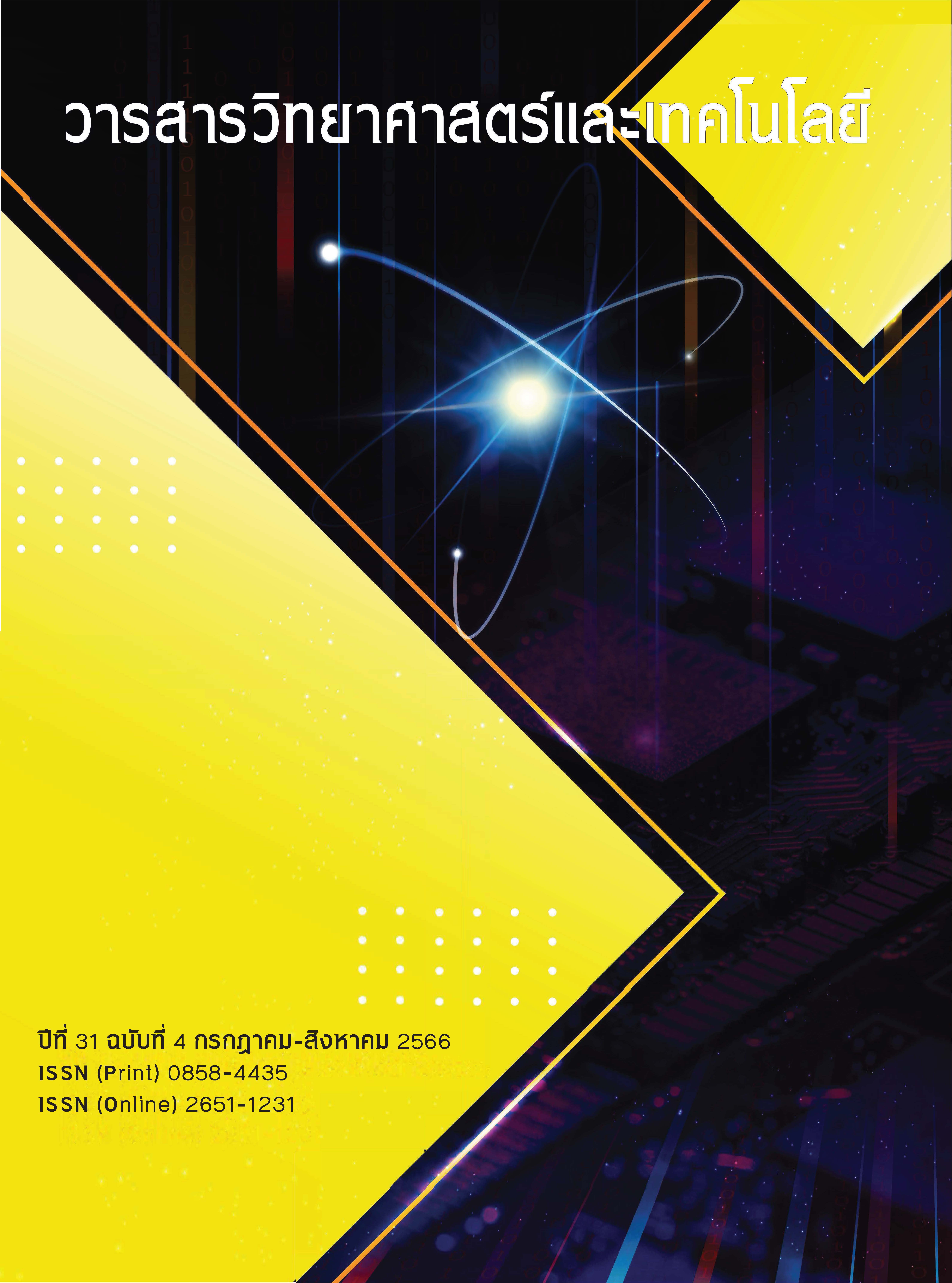Starch Granule and Chemical Structure of Flour from Local Yams in Dioscorea spp.
Main Article Content
Abstract
The objective of this research was to study the physical characteristics of starch and starch granules, the composition and chemical structure, and to analyze the similarities and variations in flour characteristics among six species of the local yams in Dioscorea spp., which varied in physical appearance, color, the texture. The yam species included Mun-Jao-Ma-Praw, Mun-Khao, Mun-Talab, Mun-Meu Seu, Mun-On, and Mun-Lued-Nok. The extracted flour was analyzed to determine the color, starch granules, elemental composition, crystal structure, and functional groups by colorimeter, SEM, EDX, XRD, and FTIR, respectively. It was found that the physical characteristic of local yam flour was significantly different from the color index. The flour from Mun-Meu-Seu had the maximum white brightness, while the reddest and yellowest color in Mun-Lued-Nok flour was presented. According to the starch granule examination, it could be classified the starch granule of yams in this family into two types. The starch granule appearance of the flour from Mun-Jao Ma-Praw, Mun-Khao, Mun-Talab, and Mun-Lued-Nok are enormous and oval in shape with a similar amount of carbon atoms as oxygen, or slightly more, in compared to the starch granules from Mun-Meu-Seu and Mun-On was narrow and polyhedral in physical form which It possessed more carbon atoms than oxygen. The characteristics of the Dioscorea family of flour from local yams could be confirmed from the analysis of the crystal structure and functional group, which revealed that all six species in Dioscorea spp. have B type which contains more water molecules than other sorts in the crystal structures. Moreover, the functional groups of the chemical structure of flours in this category were identical. The investigation might serve as a database that can contribute to regional value enhancement and protection of indigenous vegetation.
Article Details
References
FAOSTAT. Statistical database of the Food and Agriculture Organization of the United Nations 2022. Available Source:http://faostat.fao.org/site/339/default.aspx, January 14, 2023.
Morse, S., 2022, The role of plant health in the sustainable production of seed yams in Nigeria: A challenging nexus between plant health, human food security, and culture, Plant Pathol. 71: 43–54.
Owusu, D.E., Danquah F.O., Frimpong, F., Dankwa, K.O., Weebadde, C.K., Ennin, S.A., Asante, M.O.O., Brempong, M.B., Dwamena, H.A., Addo-Danso, A., et al., 2022, Sustainable Intensification and Climate-Smart Yam Production for Improved Food Security in West Africa, A Review. Frontiers in Agronomy. 4: 858114.
Robert, A., Alieu, S., 2010, Crops that feed the World 1. Yams Yams for income and food security, Food Secur., 2: 305–315.
Obidiegwu, J.E., Akpabio, E.M., 2017, The geography of yam cultivation in southern Nigeria: Exploring its social meanings and cultural functions, Journal of Ethnic Foods. 4:28–35.
Rugchati, O., Thanacharoenchanaphas, K., 2010, Comparison in some characteristics of yam tubers starch (Dioscorea. spp.) from Thailand, International Journal of Environmental and Rural Development. 1(2): 102-106. (in Thai)
Harijono, T.E., Saputri, D.S., Kusnadi, J., 2013, Effect of blanching on properties of water yam (Dioscorea alata) flour, Advance Journal of Food Science and Technology. 5: 1342–1350.
Westphal, E., Arora R.K., 1989, Prosea Project.: Plant resources of South-East Asia., Pudoc, Wageningen, The Netherlands, 238 p.
Department of Agriculture, Thailand. Mun-Meu-Seu 2565. Available Source: https://www.doa.go.th/pvp/wpcontent/uploads/2022/07/%E0%B8%A1%E0%B8%B1%E0%B8%99%E0%B8%A1%E0%B8%B7%E0%B8%AD%E0%B9%80%E0%B8%AA%E0%B8%B7%E0%B8%AD.pdf, February 9, 2023. (in Thai)
Chandrasekara, A., Josheph, K.T., 2016, Roots and tuber crops as functional foods: A review on phytochemical constituents and their potential health benefits, Int J Food Sci. 3: 3631647.
Pozo, C., Rodríguez-Llamazares, S., Bouza, R., Barral L., Castaño, J., Müller, N., Restrepo, 2018, I., Study of the structural order of native starch granules using combined FTIR and XRD analysis. Journal of Polymer Research. 25: 1-8.
Vazquez, A., Cyras, V.P., Alvarez, V.A., Moran, J.I., 2012, Starch/Clay Nano-Biocomposites, Green Energy and Technology. 50: 287–321.
Oyeyinka, S.A., Toyin, O.A., Kayode, R.M., Olagunju, O.F., Adeoye, O.S., Monday, K.R., Folake, O.O., Karim, R., Kolade, J.J., 2017, A Review on the functionality and potential applications of bitter yam starch, Annals. Food Science and Technology. 18(3): 364-375.
Larief R., Dirpan A., Theresia, 2018, Purple Yam Flour (Dioscorea alata L.) Processing Effect on Anthocyanin and Antioxidant Capacity in Traditional Cake “bolu Cukke” Making. In IOP Conference Series: Earth and Environmental Science. Institute of Physics Publishing. 207: 102043.
Tamaroh, S., Sudrajat, A., 2021, Antioxidative Characteristics and Sensory Acceptability of Bread Substituted with Purple Yam (Dioscorea alata L.). Int J Food Sci. 2021: 5586316.
Riley, C.K., Wheatley, A.O., Asemota, 2006, Isolation and Characterization of Starches from eight Dioscorea alata cultivars grown in Jamaica. Afr J Biotechnol. 5: 1528–1536.
Jiang, Q., Gao, W., Li, X., Xia, Y., Wang, H., Wu, S., Huang, L., Liu, C.-X., Xiao, P.-G., 2012, Characterizations of starches isolated from five different Dioscorea L., Food Hydrocoll. 29: 35–41.
Chatpapamon C., Santhanee P., Uttapap D., 2016, Effect of Heat-moisture Treatment on Properties and Structure of A-and B-crystalline Type Starches, KMUTT Research and Development, 23(2): 257-270. (in Thai)
Ghanbarzadeh, B., Almasi, H., Entezami, A.A., 2010, Physical properties of edible modified starch/carboxymethyl cellulose films, Innovative Food Science and Emerging Technologies. 11: 697–702.
Alcázar-Alay, S.C., Meireles, M.A.A., 2015, Physicochemical properties, modifications and applications of starches from different botanical sources. Food Science and Technology (Brazil). 35: 215–236.
Amaraweera, S.M., Gunathilake, C., Gunawardene, O.H.P., Fernando, N.M.L., Wanninayaka, D.B., Dassanayake, R.S., Rajapaksha, S.M., Manamperi, A., Fernando, C.A.N., Kulatunga, A.K., et al., 2021, Development of starch-based materials using current modification techniques and their applications: A review, Molecules. 26: 6880.
Jayakody, L., Hoover, R., Liu, Q., Donner, E., 2009, Studies on tuber starches III. Impact of annealing on the molecular structure, composition and physicochemical properties of yam (Dioscorea sp.) starches grown in Sri Lanka, Carbohydr Polym. 76: 145–153.
Lawal, O.S., Lechner, M.D., Kulicke, W.M., 2008, Single and multi-step carboxymethylation of water yam (Dioscorea alata) starch: Synthesis and characterization, Int J Biol Macromol. 42: 429–435.
Ogunjobi, J.K., Balogun, O.M. 2021, Isolation, modification and characterisation of cellulose from wild Dioscorea bulbifera, Sci Rep. 11: 1025.


